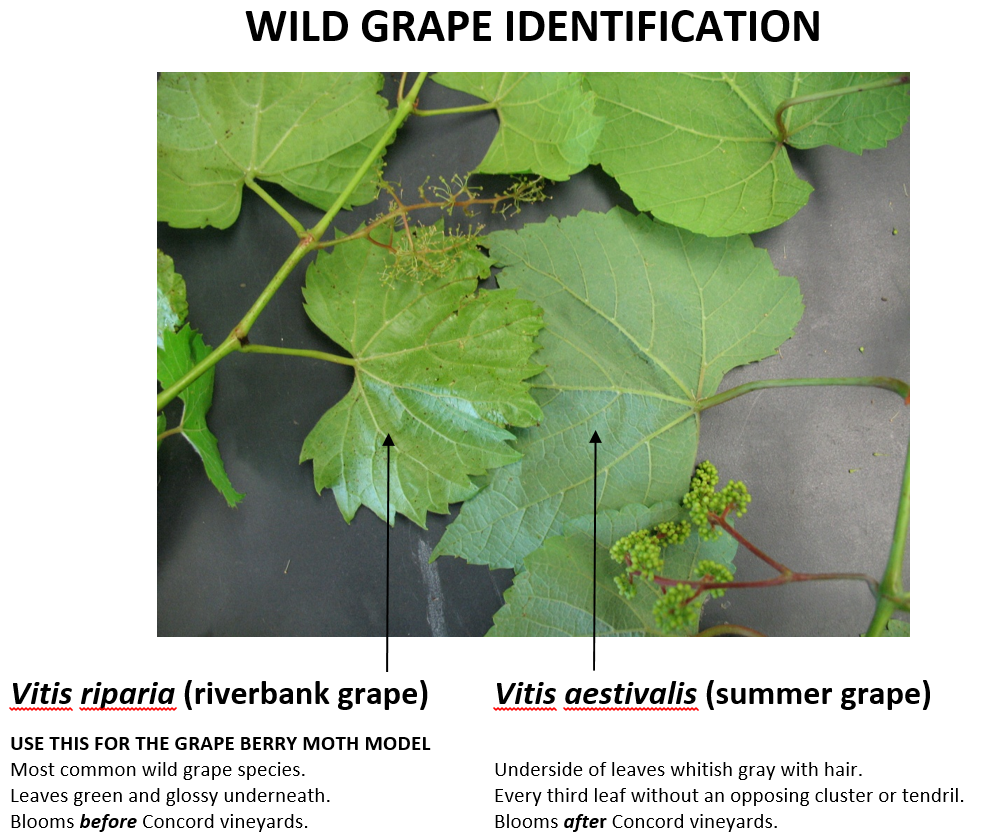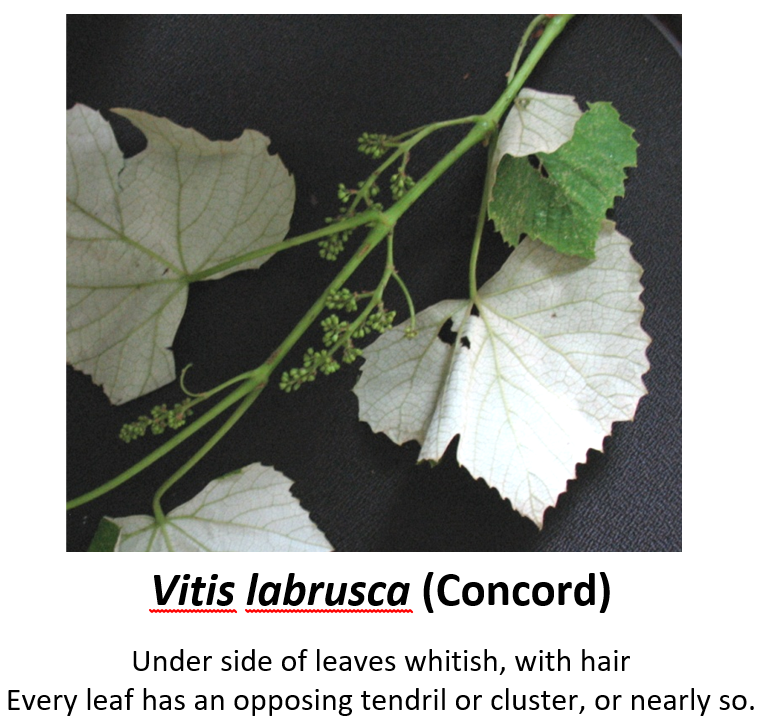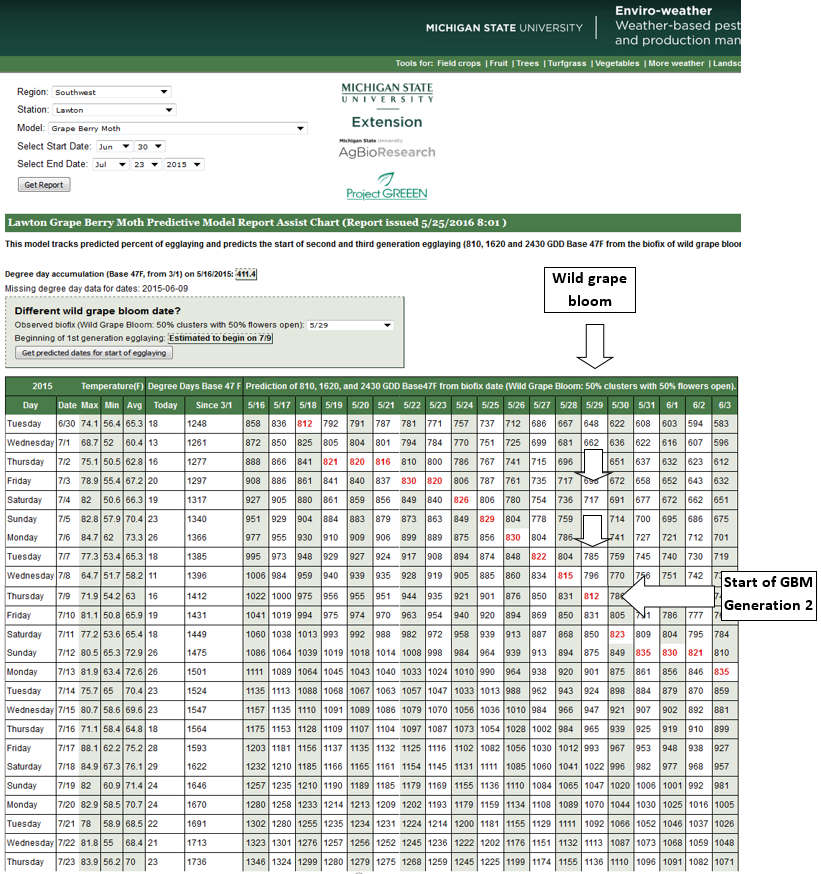Using the MSU Enviroweather grape berry moth model in 2018
It is important to know when wild grape blooms in your vineyard so you know when to start degree-day accumulation.

We have been tracking the development of wild grape (Vitis riparia) across Michigan for the last several weeks, and we have now recorded bloom in all major grape growing regions. These dates are used as the starting point for the Michigan State University Enviroweather grape berry moth degree-day model. If you were not able to record wild grape bloom on your own farm, you can use the dates in Table 1 below as good local approximations. You will need this date for the biofix to run the model and determine when the mid-summer and late-season generations of grape berry moth are likely to begin laying eggs in your area.
|
Table 1. Estimated dates of wild grape bloom in 2018 for Michigan. | ||
|---|---|---|
|
County |
Location |
Wild grape bloom date |
|
Van Buren |
Lawton |
May 26 |
|
Paw Paw |
May 26 |
|
|
Mattawan |
May 28 |
|
|
Berrien |
Baroda |
May 27 |
|
Berrien Springs |
May 27 |
|
|
Scotdale |
May 27 |
|
|
Benton Harbor |
May 28 |
|
|
Allegan |
Fennville |
May 28 |
|
Leelanau |
Sutton’s Bay |
June 7 |
|
Bingham |
June 7 |
|
|
Grand Traverse |
Old Mission Peninsula |
June 7 |
Background
Grape berry moth typically has three generations per season in southwest Michigan. Predicting when these occur can help growers target management at the right time to reduce infestation by this pest. Preventing the mid- and late-season infestation is most important, and accurate timing of controls is essential for effective management of grape berry moth. Controlling generation two (July) and three (August) is key to minimizing infestation at harvest time and reducing the cluster rots that can be associated with berry moth-infested clusters.
Timing of controls
The MSU Enviroweather grape berry moth degree-day model has been developed to predict the start of egglaying in the second and third generations in Michigan vineyards. It uses growing degree-days (GDD) accumulated after wild grape bloom, so it is important to record the date of wild grape bloom in your vineyards to run this model. This pest takes 810 GDD (base 47 degrees Fahrenheit) to complete a generation, and egglaying starts to increase at around 810 GDD after wild grape bloom for the second generation and 1,620 GDD after wild grape bloom for the third generation. This information is the foundation of the model to focus the timing of sprays to reduce late-season grape berry moth infestation.
For insecticides with activity on eggs and young larvae such as insect growth regulators, diamides or biologically derived insecticides, (Intrepid, Altacor, Delegate or B.t., respectively) applications made at 810 and 1,620 GDD provide superior control of grape berry moth compared to waiting until later. MSU research trials to test reduced-risk insecticides in high pressure vineyards found good to excellent control of grape berry moth using Intrepid (12 ounces per acre) applied in early-mid July (810 GDD) and early- to mid-August (1,620 GDD).
We have also shown that using Intrepid at 810 GDD and Altacor at 1620 GDD provides excellent control, plus the Altacor is active on Japanese beetle with equivalent performance to Capture (bifenthrin) in reducing foliage damage.
Most broad-spectrum contact insecticides (Imidan, pyrethroids, etc.) should be timed for when larvae hatch from eggs, which occurs about 100 GDD after eggs are laid. This makes the target times for broad-spectrum compounds 910 (second generation) and 1,720 GDD (third generation). These target timings will provide improved control because the insecticides applied for egg hatch will have greater residual activity during the period when grape berry moth are crawling on the surface of the berry before they start feeding. However, reapplication of these shorter-active chemicals may be needed to ensure growers protect their berries for the full activity periods of the second and third generations of grape berry moth.
Running the MSU Enviroweather grape berry moth model
Step 1. Record when wild grape (Vitis riparia) is in bloom near your vineyard, typically in late May. See table above for 2018 local estimates. The date to record is when approximately 50 percent of the flowers are open on approximately 50 percent of the wild grape clusters. Make sure you have the right wild grape species (see photos below)!
Vitis riparia (riverbank grape) and Vitis aestivalis (summer grape). Use Vitis riparia for the grape berry moth model. This is the most common wild grape species. Leaves are green and glossy underneath and blooms before Concord varieties. The underside of leaves of Vitis aestivalis are whitish gray with hair. Every third leaf is without an opposing cluster or tendril. Vitis aestivalis blooms after Concord.
Vitis labrusca (Concord). Underside of leaves are whitish with hair. Every leaf has an opposing tendril or cluster, or nearly so.
Step 2. Go to MSU Enviroweather and select the nearest weather station to your farm. Select “Fruit,” then “Grape” and then “Grape Berry Moth” in the Pest Management section. A new page will appear with a table that has dates and daily degree-day totals on the left and wild grape bloom date across the top.
Step 3. Look across the top of the table for the dates when wild grape bloomed on your farm. Look down the table for the row where the text in the table turns red, indicating 810 (and later 1,620) GDD after wild grape bloom (base 47 F). These red shaded boxes indicate the timing of the start of egglaying by the second generation of grape berry moth. Later in the summer, at 1,620 GDD after wild grape bloom, another series of red boxes will indicate the start of the third generation.
The example table shown below is for the Lawton Enviroweather station in 2015. Wild grape bloom was recorded on May 29 (top line of the table), and 810 GDD was predicted to accumulate by July 9. The red text indicates when egglaying of the second generation was predicted to start. Sites with later wild grape bloom will have later egglaying by the second generation.
If you don’t have a wild grape bloom date from your farm, use the dates that will be given in the MSU Extension grape scouting reports, available at the MSU Extension Grapes website.
Example print-out of degree-day model for grape berry moth from 2015 season at Lawton Enviroweather station. Find this model at MSU Enviroweather, click on the nearest weather station, click on “Fruit” then click on “Grape berry moth.”
Step 4. Make management decisions. The model provides information on timing for the start of second and third grape berry moth generations, at 810 and 1,620 GDD. It does not tell you anything about the need for treatment. Those decisions need to be made based on pest scouting and vineyard history. For growers using growth regulator insecticides, application at 810 or 1,620 is appropriate. Use 910 and 1,720 for broad-spectrum insecticides to target egg-hatch.
If you decide to make an insecticide application to control the second or third generation of grape berry moth, be sure to get the spray well covered on the clusters. This may require higher water volume and spraying every row. If it doesn’t cover the clusters, it isn’t going to work for you!
Thanks to National Grape Cooperative, Project GREEEN, MSU IPM Program, North Central IPM Program and MSU Enviroweather for support of this project.



 Print
Print Email
Email

